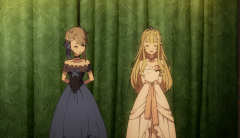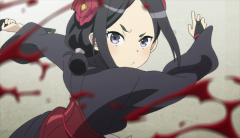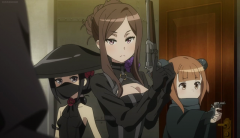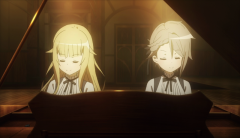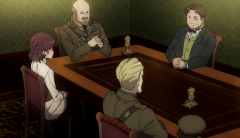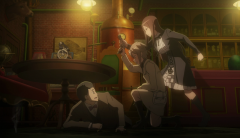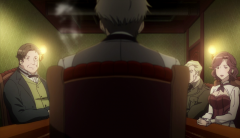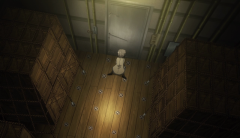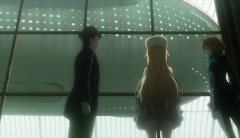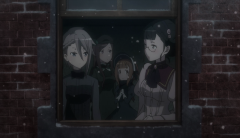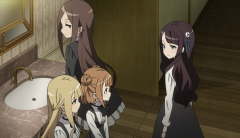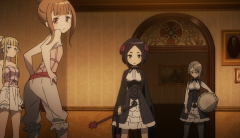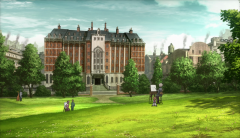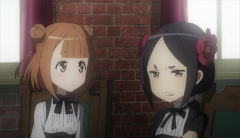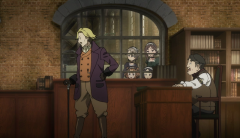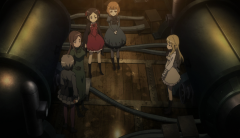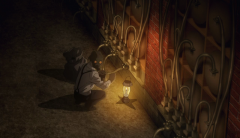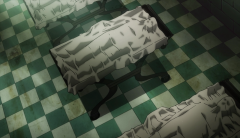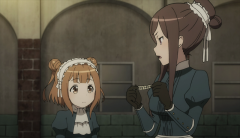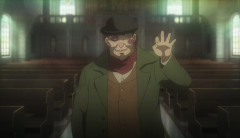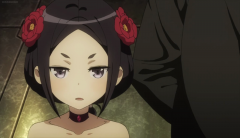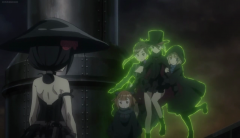Princess Principal has emerged as a true sleeper hit for this admittedly sloppy Summer Season. A joint project from indie studios that bring us my favorite anime of last year Flip Flappers (3Hz) and “better than it has any right to be” Girls und Panzer (Actas), Princess Principal records the missions of five cute spy girls in an alternate Britain (known as Albion) in the early 20th century. As ill-advised as it might sound, the cute girl designs don’t really bother me that much. If you are looking for a true espionage story; however, you bound to be disappointed because they’re more like James Bond flashy action, somewhat superpower ability and whenever they have a chance, they’ll announce “We’re spy” with pride. Yeah, it’s that kind of mindless over-the-top action series that we need to believe the unbelievable but as an action-spy-steampunk series, Princess Principal delivers what it promised.
The first strength of this show lies in its intriguing world settings. I might have personal issues with Ichirou Okuochi as a whole, but even I don’t deny that he can create an interesting setting that triggers my curiosity. Princess Principal has such fascinating world. In this vision, Albion monopolizes a powerful substance known as Cavorite that made the Kingdom the dominant country in the world. Such development creates a rift between the Royalty and the lower people and as a result, the Wall of London was built in the middle of London where the country is split into The Commonwealth and the Kingdom. The tension between the two nations, however, never really addressed at all and only serves as a backdrop to generate dramatic development for our two main leads, Ange and Princess. In addition, the steampunk setting makes for an aesthetic pleasure and I would argue that it’s Princess Principal’s strongest characteristics.
However, Princess Principal isn’t just merely an action show. The five girls have some interesting developments and each of them is given a solid backstory. Moreover, they have solid dynamic altogether that make the interactions between them a joy to watch. Noticeably, in the latter half when the cases become less prevalent, and the show slowed down the fast tempo mission-heavy established in the first half for more character-focus episodes. The change might turn off some of the viewers who look for quick-paced, entertaining action but it’s a welcoming sign that the show gave a proper time to flesh out the five girls. The relationship between Ange and Princess serves as the show’s central emotional arc and while the swapped-identity backstory had its merits, the show pad it out way too thin during the climax that it couldn’t transfer the emotions to its fullest. Other girls, especially Chise and Dorothy (sorry Beatrice! You have a voice… but nothing else) have so much personality to them and they all add necessarily perspectives (Chise- from the outside perspective; Dorothy- friends come first) to the Principal team. Not that they’re a deepest bunch around but I’m quite happy to spend time with them anytime.
Another factor that add to Princess Principal’s identity is its use of non-chronological order. This technique works for the show’s benefits most of the time because these episodes feel like a piece in a jigsaw puzzle (which admittedly doesn’t add up much at the end), and up in till the climax we can watch these episodes in any order and it still makes sense. This format will work well on re-watch as well since there are some already-established relationships or a piece of information that will make more sense now we know the context. But presenting it non-linearly doesn’t mean the episodes were arrange randomly. The flow from one episode to another is present and moreover, this format helps us gaining context on certain themes, on certain character developments that otherwise would be insignificant in a linear way. For example we gain an extra layer on Chise struggling with the social-class issues through the backstory of Ange and Princess established a week before, something that won’t have much impact if they tell the story in a linear fashion.
Thus, Princess Principal is at its best in episode 5 (the introduction of Chise) where it focused on the exciting mission, while never forget to give our girls an extra depth. In that episode, the fluid animation, flawless fight choreography and the lively character movements help bring the mannerism of our characters to light. On the other spectrum, the last two episodes bring the show down a notch with its safe open-ended closure that resolve almost nothing. In addition, they introduced new characters (Zelda, the General) and new conflict (the coup) too late in the game without any proper foreshadowing beforehand. Remember Princess wanted to fight that battle till the end? Flashforward and we see her lying on the beach in Casablanca, while holding hand with another girl. It’s a let-down, of course, especially when they hint for a second season which might never come, but to be frank the first 10 episodes were so solid that in the end I consider this show a critical success.
Technically, the production is on the bright side. Off-model here and there, cheap-cuts sometimes and they do have some questionable over-cute character designs, but the action always hold its ground, characters move in their own ways that fitting to their personality and the killer soundtrack, coupling with beautiful steampunk aesthetic and you have a winner all around. Princess might not dig deep to the political conflict between two countries, or develop its Cavorite theme and the enemy side is frankly, weak and underdeveloped; but Princess Principal offers some entertaining action set-pieces, at the same time care enough to develop properly the main cast and their relationships. Second season- coming might not look promising and the ending lacks bite, but I don’t argue that I had a great time following it the past season. Can’t never get enough of Chise’s precious facial expressions, it appears.

